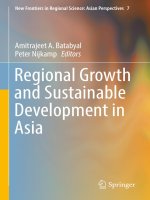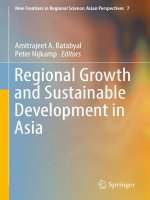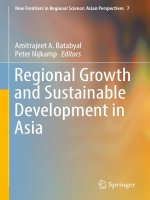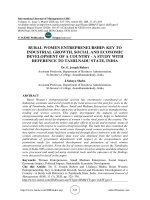Economic growth and economic development 697
Bạn đang xem bản rút gọn của tài liệu. Xem và tải ngay bản đầy đủ của tài liệu tại đây (115.8 KB, 1 trang )
Introduction to Modern Economic Growth
This is no longer true when δ > 0. To characterize the results in this case,
let us combine condition (15.36) with equations (15.15) and (15.18), we obtain the
equilibrium relative technology as (see Exercise 15.9):
1
ả
à
à ả 1
ả 1−δσ
µ
σ
1
−
γ
H
NH
= η 1−δσ
,
(15.37)
NL
γ
L
where recall that η ≡ η H /η L . This expression shows that the relationship between
the relative factor supplies and relative physical productivities now depends on δ.
This is intuitive: as long as δ > 0, an increase in NH reduces the relative costs of
H-complementary innovations, so for technology market equilibrium to be restored,
π L needs to fall relative to π H . Substituting (15.37) into the expression for relative
factor prices for given technologies, which is still (15.19), yields the following longrun (endogenous-technology) relationship between relative factor prices and relative
factor supplies:
(15.38)
à
wH
wL
ả
=
1
1
à
1
à
ả (1)
1
H
L
ả 2+
1
.
It can be verified that when δ = 0, so that there is no state-dependence in R&D,
both of the previous expressions are identical to their counterparts in the previous
section.
The growth rate of this economy is determined by the number of scientists. In
BGP, both sectors grow at the same rate, so we need N˙ L (t) /NL (t) = N˙ H (t) /NH (t),
or
η H NH (t)δ−1 SH (t) = η L NL (t)δ−1 SL (t) .
Combining this equation with (15.33) and (15.37), we obtain the following BGP
condition for the allocation of researchers between the two dierent types of technologies,
(15.39)
1
1
à
1
à
ả (1)
1
H
L
ả (1)(1)
1
=
SL
,
S SL
and the BGP growth rate (15.40) below. Notice that given H/L, the BGP researcher
∗
, are uniquely determined. We summarize these results with
allocations, SL∗ and SH
the following proposition:
683









